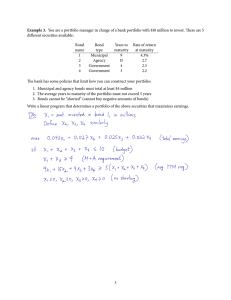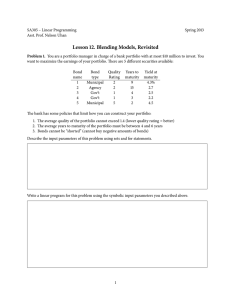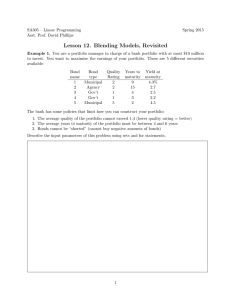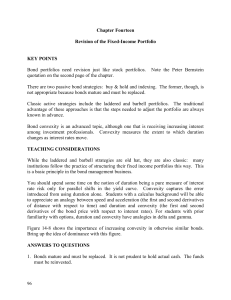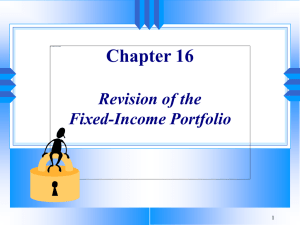ANSWERS TO QUESTIONS funds must be reinvested.
advertisement
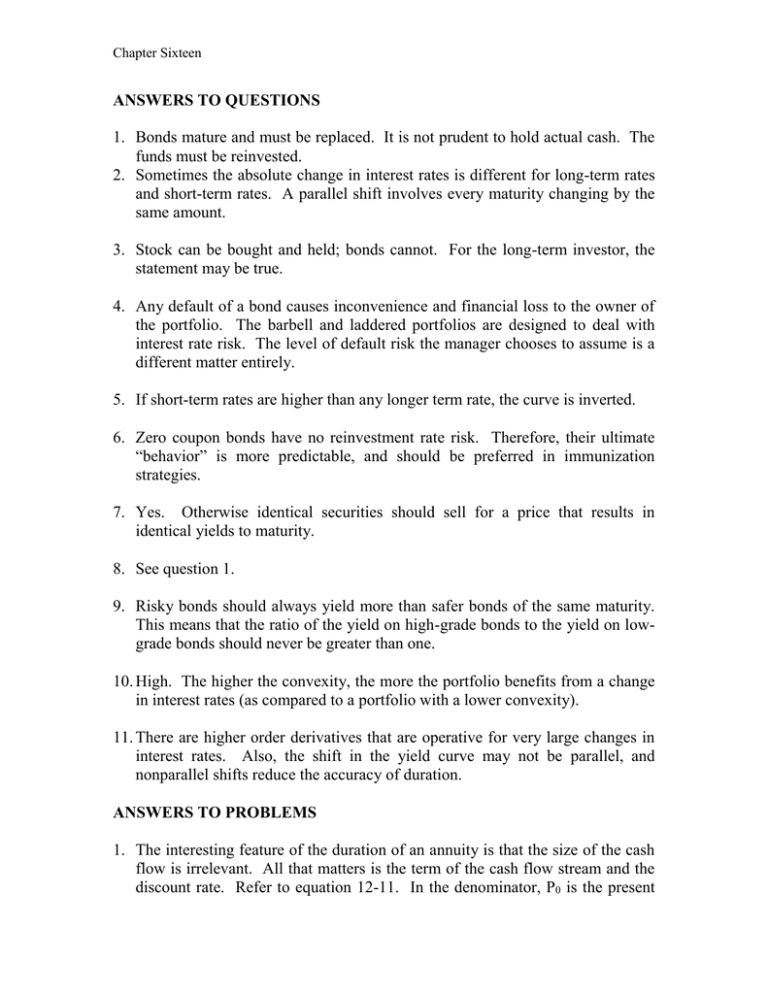
Chapter Sixteen ANSWERS TO QUESTIONS 1. Bonds mature and must be replaced. It is not prudent to hold actual cash. The funds must be reinvested. 2. Sometimes the absolute change in interest rates is different for long-term rates and short-term rates. A parallel shift involves every maturity changing by the same amount. 3. Stock can be bought and held; bonds cannot. For the long-term investor, the statement may be true. 4. Any default of a bond causes inconvenience and financial loss to the owner of the portfolio. The barbell and laddered portfolios are designed to deal with interest rate risk. The level of default risk the manager chooses to assume is a different matter entirely. 5. If short-term rates are higher than any longer term rate, the curve is inverted. 6. Zero coupon bonds have no reinvestment rate risk. Therefore, their ultimate “behavior” is more predictable, and should be preferred in immunization strategies. 7. Yes. Otherwise identical securities should sell for a price that results in identical yields to maturity. 8. See question 1. 9. Risky bonds should always yield more than safer bonds of the same maturity. This means that the ratio of the yield on high-grade bonds to the yield on lowgrade bonds should never be greater than one. 10. High. The higher the convexity, the more the portfolio benefits from a change in interest rates (as compared to a portfolio with a lower convexity). 11. There are higher order derivatives that are operative for very large changes in interest rates. Also, the shift in the yield curve may not be parallel, and nonparallel shifts reduce the accuracy of duration. ANSWERS TO PROBLEMS 1. The interesting feature of the duration of an annuity is that the size of the cash flow is irrelevant. All that matters is the term of the cash flow stream and the discount rate. Refer to equation 12-11. In the denominator, P0 is the present Chapter Sixteen value of the cash flow stream, and this is the same as the formula for the present value of an annuity (equation 2-9). The duration of an annuity is therefore D 1 R N R (1 R ) N 1 Solving this problem as an ordinary annuity, D 1.10 20 = 11 – 3.49 = 7.51 .10 (1.10) 20 1 Solving as an annuity due (which it probably would be), D 1.10 20 = 11 – 3.91 = 7.09 .10 (1.10)19 1 2. a. Dollar weighted approach: Bond ABC DEF GHI JKL Total Value $980 870 1020 900 $3770 Duration 3.39 5.70 8.79 9.11 Weighted Duration 0.88 1.32 2.38 2.17 6.75 b. Single security approach: yield to maturity = 11.00% and duration = 6.75 3. N = 4 C = 10% P = 98 YTM = 10.63% convexity = 12.95 4. Calculate modified duration: Dmod D 3.39 3.22 (1 R ) 1 .1063 2 2 a. using duration only: 3.22 x .005 = .0161 = 1.61% b. using duration and convexity: Chapter Sixteen change from convexity = 21.97 x (.005)2 = 0.000549 = 0.0549% total change = 1.61% + .05% = 1.66% (to two decimals) 5. Student response 6. Refer to Figure 16-5. The additional duration associated with a lengthening maturity declines as maturity increases. (This is what one of Malkiel's theorems states.) The barbell portfolio is weighted more heavily in the early years, and so these years receive a significant weight in the calculation of portfolio duration. The barbell portfolio, therefore, has less interest rate risk. 7. Use the DURATION file with par = 0 and N = some high number; Duration = 10.00 8. The barbell portfolio might be composed of bonds with very high coupons, or the size of the “weights” on the bar might be very large. Either of these characteristics will reduce the portfolio duration. 9. The point here is that you have control over the coupons you select. You can choose lower coupons in the maturities corresponding to the weights, and higher coupons on the bar. There is no set size of the weights either, so you can tamper with them to get the cash flow stream the way you want it. 10. Calculate modified duration Dmod D 6.4 6.07 (1 R ) 1 .1100 2 2 (-6.07 x -0.005) + 125 x 0.5 x (-.005)2 = 3.20% The new price will equal the old price plus 3.20%, or 94 (1.0320) = 97.0
